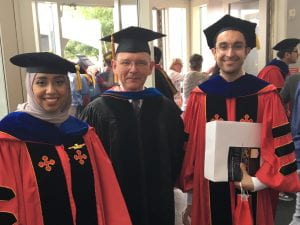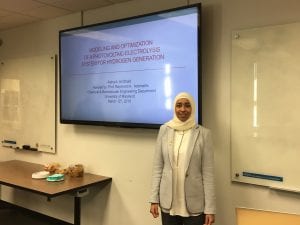After spending nearly a day getting Open Modelica running on my MacBook, I decided to write things down to hopefully help others in the group avoid the problems and ambiguities I encountered. My Mac operating system is OS X 10.11.6 at this time.
At the start of the installation, I had two accounts on my computer: Admin and ray, with admin and regular user privileges, respectively. Following directions on the Open Modelica download page, I downloaded MacPorts, skipping the Xcode installation entirely without any problems so far. I used my own account but made sure MacPorts installed in the root directory. Next,
echo rsync://build.openmodelica.org/macports/ >> /opt/local/etc/macports/sources.conf
which would not work even from the Admin account – permission was denied because the file sources.conf was owned by wheel and so I could not append the path above. To solve this, I enabled my root account, logged into it, and finally was able to execute this command. I then switched to Admin, enabled admin privileges for ray to add that account to the sudo list. I then went back to account ray and did everything from there (not from root as specified on the OpenModelica page). I then
sudo port selfupdate
sudo port install gcc44
sudo port install openmodelica-devel +libraries
which all went well except for some warnings during the gcc installation.
At this point, Modelica was installed as basically a set of libraries – looking in /Applications/MacPorts, no applications were found. So then I went to to the OpenModelica OMEdit page and downloaded from nightly builds/mac/binaries/release the 1.12.0 version .mkpg and installed that. That not only gave me OMEdit.app but also OMNotebook.app, OMShell.app, and Python 2.7 – more on that next. Note that all of the Modelica software above takes about 6-7 GB of space.
To check if things are working, the following should produce a plot of a bouncing ball (note that the location of BouncingBall.mo may be different for you). To start, click on OMShell.app and then enter
loadModel(Modelica)
loadFile(“/opt/openmodelica/share/doc/omc/testmodels/BouncingBall.mo”)
list(BouncingBall)
simulate(BouncingBall, stopTime=3.0)
plot({h})
To test my own ODE model, I first created the file test.mo located on my desktop and containing:
model firstODE “First order initial value problem”
Real x “State variable”;
initial equation
x = 2 “Initial condition”;
equation
der(x) = 1-x;
end firstODE;
and then
cd(“/Users/ray/desktop”)
loadFile(“test.mo”)
simulate(firstODE, startTime=0, stopTime=3)
plot(x)
Note that loadFile() will return a false if there are syntax errors or special characters in the test.mo file.
Python
After adding a 0.5 TB SSD to my laptop I needed to reinstall Python. I’ve used the Enthought distribution in that past because the version of Python that comes with OS X does not have PyLab and other packages we use. Since the previous time I installed it, Enthought seems to have wrapped its Python distribution with a deployment manager environment EDM. This works well for me because I always use Python from the command-line interface. After installation of EDM, I needed to install the packages we use by opening a terminal window and
edm install
to install the edm shell and then
edm install scipy
edm install matplotlib
edm install pyside
edm install networkx
and more. Note that pyside is needed for matplotlib to work because it provides the GUI toolkit Qt necessary to display the plots. To run a python script
edm python myscript.py
and to use python interactively
edm shell
python
I also installed Enthought’s canopy which provides a graphical Python package manager and an interactive analysis environment that includes a code editor, IPython window, and simplified Jupyter access. I downloaded the 64-bit macOS Python 2.7b distribution which includes everything we need except networkx which can be downloaded using the Canopy package manager. Note that the first time I opened the Canopy editor, I had to Reset the python environment… through Canopy Tools => Troubleshoot menu.
LaTeX
I have been using the same distribution of LaTeX for 10 years. Therefore, I’m going to try MacTeX 2018 since it seems to include every package we use (including ChemFig?) and TeXShop as the front end. After downloading and installing it, everything worked perfectly.





 The electrochemical cell model then was combined with models for a PV array, battery system, and solar irradiance model which was optimized using several multi-objective optimization procedures. Aisha will return to Kuwait this fall to start her academic career as a professor in the Chemical & Biomolecular Engineering Department at Kuwait University
The electrochemical cell model then was combined with models for a PV array, battery system, and solar irradiance model which was optimized using several multi-objective optimization procedures. Aisha will return to Kuwait this fall to start her academic career as a professor in the Chemical & Biomolecular Engineering Department at Kuwait University Early on Saturday 17 November 2018, an
Early on Saturday 17 November 2018, an  Waste heat from the ISS is radiated to space by the large white panels seen in the top image. The pigment used to coat these radiators is designed for optimal emission of waste thermal radiation and minimal absorption of solar radiation. Because the (electrically) insulating pigment can become differentially charged in LEO, our group has been working in conjunction with NASA’s Goddard Space Flight Center to develop ultra-thin conductive coatings that do not interfere with the optical properties of the pigments and allow for the dissipation of static charge.
Waste heat from the ISS is radiated to space by the large white panels seen in the top image. The pigment used to coat these radiators is designed for optimal emission of waste thermal radiation and minimal absorption of solar radiation. Because the (electrically) insulating pigment can become differentially charged in LEO, our group has been working in conjunction with NASA’s Goddard Space Flight Center to develop ultra-thin conductive coatings that do not interfere with the optical properties of the pigments and allow for the dissipation of static charge. Conductive thin films (less than 100 atoms thick) of indium oxide (IO) and tin-doped indium oxide (ITO) were deposited by atomic layer deposition (ALD) on the pigment nanoparticles to create four samples that will be flown on this mission (an earlier MISSE mission image is seen in the center image; details of our mission are described in the
Conductive thin films (less than 100 atoms thick) of indium oxide (IO) and tin-doped indium oxide (ITO) were deposited by atomic layer deposition (ALD) on the pigment nanoparticles to create four samples that will be flown on this mission (an earlier MISSE mission image is seen in the center image; details of our mission are described in the Aisha and Hossein have arrived in Pittsburgh, PA for the 2018 AIChE Annual meeting. As can be seen in the top image, Aisha’s and Hossein’s posters were side-by-side during Monday afternoon’s poster session. Hossein’s poster focused on our group’s species-reaction graph analysis approach to chemical reaction networks. He will also be giving a talk on Wednesday on our NASA-sponsored atomic layer deposition of indium oxide thin films.
Aisha and Hossein have arrived in Pittsburgh, PA for the 2018 AIChE Annual meeting. As can be seen in the top image, Aisha’s and Hossein’s posters were side-by-side during Monday afternoon’s poster session. Hossein’s poster focused on our group’s species-reaction graph analysis approach to chemical reaction networks. He will also be giving a talk on Wednesday on our NASA-sponsored atomic layer deposition of indium oxide thin films. Aisha’s poster focused on the optimal wiring of PV cells and by-pass diodes to maximize the economic performance of the resulting PV modules under partial-shading conditions. She also gave a talk immediately following the poster session on her experimental and modeling study of the hydrogen and oxygen evolution reactions in electrolyzers used to split water.
Aisha’s poster focused on the optimal wiring of PV cells and by-pass diodes to maximize the economic performance of the resulting PV modules under partial-shading conditions. She also gave a talk immediately following the poster session on her experimental and modeling study of the hydrogen and oxygen evolution reactions in electrolyzers used to split water.